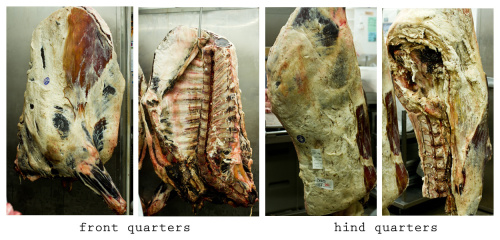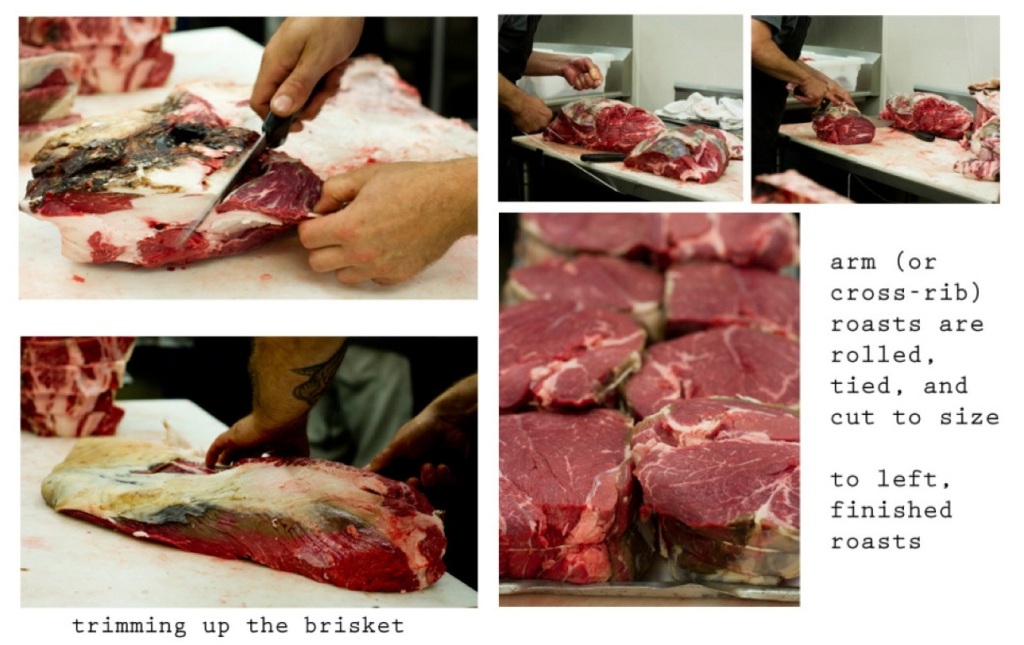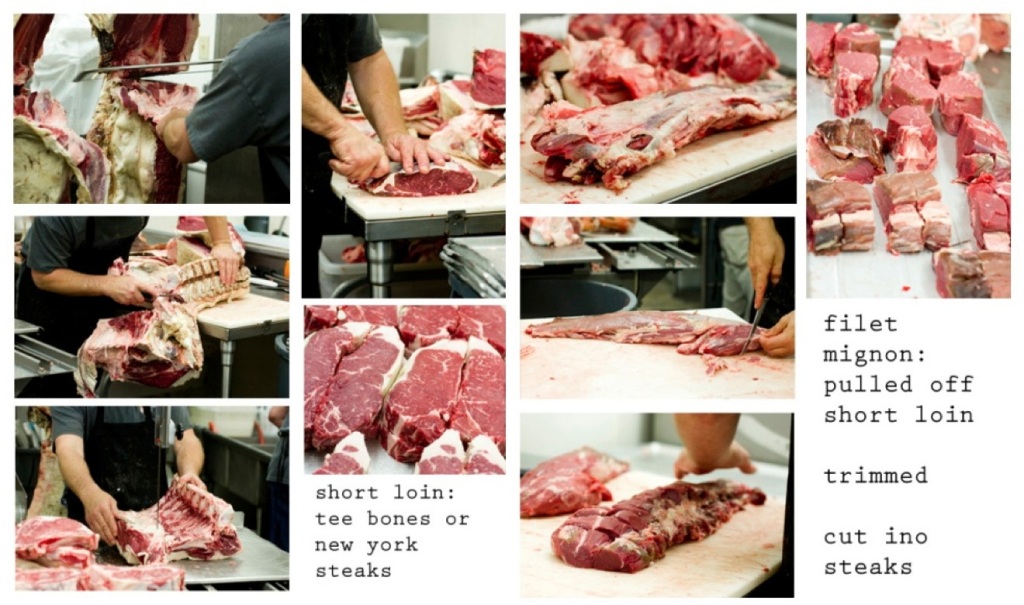How much meat do you get off a beef? How many steaks do you get? Where does “insert cut of meat” come from? I am asked these questions constantly. I will preface this by saying this post is long, but it’s informative and you will walk away from here A. knowing where your cuts of beef come from and B. being much happier when you get your 1/2 of beef cut up because you will know what to get! So here it is, processing of a beef from start to finish.
We dry age our beef for a minimum of 14 days up to 30 days depending on how large and how fat the animal is. Dry aging is described as, “when beef carcasses are stored – without protective packaging – at refrigeration temperatures for one to five weeks to allow the natural enzymatic and biochemical processes that result in improved tenderness and the development of the unique flavor,” according to an article put out by the NCBA Center for Research (http://www.beefresearch.org/CMDocs/BeefResearch/Dry%20Aging%20of%20Beef.PDF) After the dry aging process, the beef is then ready to cut. And it comes out looking like the picture above. On a whole beef, there are two front quarters and two hindquarters. Our meat cutters (or butchers) then begin what’s called breaking the beef. This basically means that the beef is broken down into manageable pieces called primal cuts which will later be cut into steaks and other cuts.
FRONT QUARTER:
- SHANK: soup bones or boned out for stew meat/ground
- PLATE: short ribs or boned out for stew meat/ground
- CHUCK: cut into chuck roasts or steaks
- RIB: steaks (bone-in or boneless) OR roasts (bone-in or boneless)
- ARM/CROSS RIB: roasts or cut up for stew meat/groun
 SHANK & CHUCK: When breaking the front quarter, the foreshank or arms are removed, the brisket is removed, and the chuck is separated from the rib. The foreshank or shank will trimmed and cut up if the customers requests soup bones, otherwise the shanks are boned. Since the meat in this area is considered tough, it will go towards ground beef and the bones will be cut up for dog bones. The next image is miscellaneous cuts that will be cleaned up, boned out, and go towards ground beef as well as six boned, rolled, and tied roasts. The third piece is the chuck which will later be cut into chuck roasts or steaks. Chuck roasts are usually cut about 2″ thick and wiped clean of bone dust. Chuck steaks can be cut as specified by the customer usually 3/4″ is standard.
SHANK & CHUCK: When breaking the front quarter, the foreshank or arms are removed, the brisket is removed, and the chuck is separated from the rib. The foreshank or shank will trimmed and cut up if the customers requests soup bones, otherwise the shanks are boned. Since the meat in this area is considered tough, it will go towards ground beef and the bones will be cut up for dog bones. The next image is miscellaneous cuts that will be cleaned up, boned out, and go towards ground beef as well as six boned, rolled, and tied roasts. The third piece is the chuck which will later be cut into chuck roasts or steaks. Chuck roasts are usually cut about 2″ thick and wiped clean of bone dust. Chuck steaks can be cut as specified by the customer usually 3/4″ is standard.
BRISKET: The brisket can be used for many purposes. Depending on what the customer orders, it can be left fresh to roast the traditional way (low and slow for a long time), it can be further trimmed and used for stew meat, or we offer the option of making corned beef out of it.
ARM/CROSS RIB ROAST: Off of an average sized beef, you can get up to twelve boned, rolled, and tied oven roasts. Six from the front quarters and six from the hindquarters. We call roasts from the front quarters arm roasts, but they can also be called cross-rib roasts. Typically this area tends to be tough so slow, moist cooking methods are recommended, like stewing or braising. This area can also be cut up for kabobs, sliced for carne asada, or something that will later be marinated.
PLATE (SHORT RIBS): What is left of the front quarter is the rib and plate. The plate being separated from the rib and is the plate is where short ribs come from. Short ribs are meaty, but also contain quite a bit of connective tissue, which is why they are best when braised. Short ribs are delicious when done right and in my opinion, completely understated. Skirt steak also comes from the plate. So those of you who love our marinated skirt steaks, here is where it comes from. We typically don’t save the skirt steak on our custom beef unless requested by the customer. During the aging process, the skirt steak takes quite a beating, requiring it to be trimmed down to sometimes near nothing. It takes a really large beef for a skirt steak to remain intact after trimming. Skirt steaks are good for stir fry like fajitas or can be marinated and just simply put on the bbq.
RIB: Most cuts on the beef are pretty straight forward, it’s either/or. The rib is not one of those cuts. There are so many different options with this area sometimes it makes it hard for customers to choose. The first option is the rib can be left as a roast or cut into steaks. People always ask me, well, which is better? And my answer to that is, either. It depends on personal preference. If you like to take the time to cook a roast than go with the roast or if you don’t like to spend the time cooking and just want to throw it on the bbq then go with steaks. And this principle applies to the whole beef, just because a cut sounds good, it may just sit in the freezer for half of the year unused. Knowing your cooking style and what you like to cook is important when having a beef processed. It can be quite a costly investment so we want our customers to be able to enjoy all of the cuts ordered. If you are a repeat customer of ours and it’s that time again to give your cutting order, tell us what cuts worked for you and what didn’t. Ask us, is there anything else we can do with that area, I didn’t really use it. Anyways, back to the rib, both choices (roast or steaks) can be ordered bone-in or boneless. Steaks with the bone left in are called rib steaks and boneless steaks are called ribeyes. Roasts with the bone left on are called standing prime rib roasts and roasts that are boned are called ribeye roasts. If either the roast or steaks are boned out, those ribs are trimmed up and called beef back ribs (or bbq ribs) which is the exact same cut as the baby back ribs on a hog.
Well that is pretty much all you get out of the front quarters, any cuts not covered here are boned out, trimmed up, and used for hamburger. Phew, are you overwhelmed yet!?
HIND QUARTER:
- SIRLOIN: tri-tip (bottom sirloin), top sirloin steaks, sirloin tip (steaks or roast)
- ROUND: top round, bottom round, eye of round (roasts or steaks), rump roasts
- FLANK: flank steak
- SHORT LOIN: new york steaks OR t-bones/porterhouses, filet steaks
FLANK: The first step in breaking the hind quarter of a beef is to remove the flank which will be trimmed up for flank steak. Flank steak is considerably less tender than the more desirable cuts of the loin, but marinated or braised, flank steak can be very tender and flavorful.
TRI-TIP: Next the tri-tip is pulled and anyone reading this from California hands down knows what tri-tip is and how to prepare it. But much to our Californian disbelief, our love affair with the tri-tip is not shared with the rest of the country. So for those of you who don’t know what a tri-tip is, here you go. A tri-tip is a small triangular muscle which is normally pulled off a carcass of beef on the primal cut, bottom sirloin. Marinate it, throw it on the BBQ, and you will find out why tri-tips continue to increase in popularity throughout the West coast.
SIRLOIN TIP: Also coming from the hindquarters and the next cut of the breaking process is removing the sirloin tip. Unlike it’s name, the sirloin tip doesn’t actually come from the primal cut known as the sirloin, it comes from the round portion of the hindquarter. It is also known as a round tip steak. These steaks are good for marinating and throwing it on the bbq, braising, or using for stew meat.
SHORT LOIN: The loin is pretty straight forward unlike the rib portion of the beef. The short loin is where tee bone steaks, porterhouse steaks and new york steaks come from. If you cut the short loin bone-in than you will get tee bone steaks and porterhouses. If you cut the short loin boneless that’s where new york steaks come from and the tenderloin will be pulled as a whole piece and cut up into filet steaks. In the bone-in option, part of the tenderloin, still attached to the bone, is cut up and that is what makes a porterhouse a porterhouse. Check out this blogpost for more information about the difference. In the photos you can see the short loin is removed from the round and the sirloin is also removed, leaving just the short loin. In this example, the tenderloin (filet) is removed and the short loin is boned out and cut up into new york steaks.
SIRLOIN: The sirloin is also pretty straight forward being made up of only two cuts: the top sirloin and the bottom sirloin. The top sirloin is cut up into steaks and serves as a lower quality, more affordable steak but can have the same great flavor as a new york or tee bone steak. The bottom sirloin usually contains the tri-tip in the traditional breaking, however, we break our beef a little differently than the traditional way, we pull the tri-tip off the bottom sirloin as one of the first steps in breaking a hindquarter.
ROUND: After the loin is removed from the hindquarter all that is left is the round and the shank. The round is removed from the shank and then broken up into what is known as the top round and bottom round. These pieces can be made into roasts or cut into steaks. If the customer does not want a London broil, the top round is then cut into steaks called top round steaks. A London broil is essentially a thick cut (think 2”) top round steak.
The bottom round is also cut into steaks leaving a small piece which will be rolled and tied into a roast known as a rump roast. All cuts coming from the round require a slow-moist cooking method like braising in order to increase tenderness in the meat. The top and/or bottom round steaks can also be cut into halves or thirds (depending on the size) and tenderized/cubed. These steaks make great chicken fried steak, etc. Other uses for the round include jerky, carne asada, pastrami, corned beef, or stew meat/ground.
We leave the eye of the round on the bottom round steaks, you can see it in the photos above, If the customer wants roasts, the eye of round is left whole as a roast.
GROUND: Now what do we have left? Well all those cuts of meat were trimmed up in order to cut steaks, so all that is remaining is the trimmings and this is where ground beef comes from. With that said, anything on the beef can be cut up and ground. Say for instance, you don’t want the chuck roasts or round portion, we can add that to your ground. And for consumer information, most ground beef you buy in the store is not made up of purely trimmings. Our ground beef sold in our shop is made up of ground chuck. The trimmings and whatever other cuts the customer wanted to grind is thrown in the grinder, ran through a hamburger plate (about 3/16”), thrown back in the grinder, and run through again. The reason for grinding the meat twice is to achieve a finer grind as well as a more blended product. As you can see from the photos, after the first grind, fat and muscle are clearly seen whereas the final photo actually looks like ground beef where fat and muscle are blended. The ground beef is then portion stuffed into tubes based on what size the customer wants (typically 1 lb.) and the tubes are stapled shut.
All that is left is the bones. Femur bones and front shank bones are usually cut up for dog bones and given to the customer if requested.
HOW MUCH DO YOU YIELD…?
Now it’s down to the nitty gritty, the numbers. We charge our customers on the hot carcass weight. This means that once the beef is rolled off the truck, same day it was slaughtered, we weight it and tag it. The weight on the tag is what we charge our customers and this is fairly standard in the industry. Customers are sometimes confused by their bills when the weight says, 775 lbs. and they received 8 boxes of meat averaging around 50 lbs. Depending on how you have your beef cut, it will not weigh the same as it did when it was hanging. As I have shown you, a tremendous amount of trimming and boning will take place resulting in a much lower net weight.
Let’s break down this beef:
Hot Carcass Weight: 775 lbs.
Steaks: 139. 50 lbs. (bone in and boneless)
Roasts: 50.60 lbs. (boneless rolled)
63.40 lbs. (bone-in chuck)
114.0 lbs. total
Misc. Cuts: 49.85 lbs. (stew meat, short ribs ,etc.)
Ground Beef: 154.5 lbs.
Bones: 51.61 lbs. (this is where your weight loss is mostly, beef bones are large and people don’t think about that when they want to know where all the weight was lost)
Net Weight of Meat (bones not included): 457.85 lbs.
So taking the net weight divided by the hot carcass weight we can see that gives us 60%, which is standard. Usually you net about 52-60% finished meat off of a whole beef. If this customer would have chosen more cuts bone-in, that percentage would go up and if this customer wanted more cuts to be boneless, that percentage may drop into the high 50 percent range. So when you are buying carcass beef from someone, be sure to do the math and figure out what you are really getting for your money and realize that the carcass weight you are paying for does not equal weight of meat coming back to you.
Well, there it is. A cutting of a beef from start to finish. I hope I was able to clearly explain the process to you all and hopefully you go away from this being more informed about beef and beef cuts.
QUESTIONS? RESOURCES
If you have any questions about this, please feel free to contact us!
Check out these other great resources for cutting charts too:










Pingback: What are you hiding? Ag Gag laws aren’t the solution. | The Adventures of Dairy Carrie... I think I Need a Drink!
Hi there everyone, it’s my first pay a quick visit at this web site, and paragraph is genuinely fruitful designed for me, keep up posting these types of articles or reviews.
Pingback: National Beef Month | Chico Locker & Sausage Co. Inc.
Pingback: Our Favorite Beef Cuts for Summer | Chico Locker & Sausage Co. Inc.
Incredibly thorough and useful info! Thank you from New York!